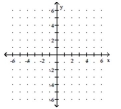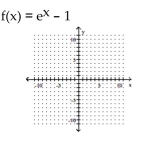A) ![]()
B) ![]()
C) ![]()
D) ![]()
Correct Answer

verified
Correct Answer
verified
Multiple Choice
Solve the equation.
- = 23 (Round to the nearest hundredth.)
= 23 (Round to the nearest hundredth.)
A) 0.57
B) 1.75
C) 3.83
D) 2.34
Correct Answer

verified
Correct Answer
verified
Multiple Choice
Express in terms of logarithms of a single variable or a number.
-
A) ![]()
B) ![]()
C) ![]()
D) ![]()
Correct Answer

verified
A
Correct Answer
verified
Multiple Choice
Express as a single logarithm.
-
A) ![]()
B) ![]()
C) ![]()
D) ![]()
Correct Answer

verified
Correct Answer
verified
Multiple Choice
Graph.
-f(x) = 

A) ![]()
B) ![]()
C) ![]()
D) ![]()
Correct Answer

verified
Correct Answer
verified
Multiple Choice
Convert to a logarithmic equation.
- = 16
= 16
A) ![]()
B) ![]()
C) ![]()
D) ![]()
Correct Answer

verified
Correct Answer
verified
Multiple Choice
Graph the function.
-
A) ![]()
B) ![]()
C) ![]()
D) ![]()
Correct Answer

verified
D
Correct Answer
verified
Multiple Choice
Express as a product.
-
A) ![]()
B) ![]()
C) ![]()
D) ![]()
Correct Answer

verified
Correct Answer
verified
Multiple Choice
Express in terms of logarithms of a single variable or a number.
-
A) ![]()
B) ![]()
C) ![]()
D) ![]()
Correct Answer

verified
Correct Answer
verified
Multiple Choice
Convert to an exponential equation.
-
A) ![]()
B) ![]()
C) ![]()
D) ![]()
Correct Answer

verified
Correct Answer
verified
Multiple Choice
Determine whether the given function is one-to-one. If so, find a formula for the inverse.
-f(x) = 
A) Not a one-to-one function
B) ![]()
C) ![]()
D) ![]()
Correct Answer

verified
Correct Answer
verified
True/False
Determine whether the function is one-to-one.
-f(x) =  - 2
- 2
Correct Answer

verified
Correct Answer
verified
Multiple Choice
Solve the problem. -In a study by psychologists Bornstein and Bornstein, it was found that the average walking speed w, in feet per second, of a person living in a city of population P, in thousands, is given by the function w(P) = 0.37 ln P + 0.05. Find the walking speed of people in a city with a population of 341,322.
A) 4.76 ft/sec
B) 9.71 ft/sec
C) 471.45 ft/sec
D) 12.79 ft/sec
Correct Answer

verified
Correct Answer
verified
Multiple Choice
Express as a product.
-
A) ![]()
B) ![]()
C) ![]()
D) ![]()
Correct Answer

verified
Correct Answer
verified
Multiple Choice
Solve.
-Let logb A = 2.572 and logb B = 0.262. Find logb  .
.
A) 2.834
B) 0.674
C) 2.310
D) 2.572
Correct Answer

verified
Correct Answer
verified
Multiple Choice
Solve.
-
A) 32
B) ![]()
C) -10
D) -25
Correct Answer

verified
Correct Answer
verified
Multiple Choice
Find an equation of the inverse of the relation.
-y = 
A) ![]()
B) ![]()
C) ![]()
D) ![]()
Correct Answer

verified
Correct Answer
verified
Multiple Choice
Using a calculator, find to the nearest ten-thousandth.
-
A) 0.6130
B) 0.0061
C) 0.0613
D) 58.3056
Correct Answer

verified
Correct Answer
verified
Multiple Choice
Express as a single logarithm.
-
A) ![]()
B) ![]()
C) ![]()
D) ![]()
Correct Answer

verified
Correct Answer
verified
Multiple Choice
Express in terms of logarithms of a single variable or a number.
-
A) ![]()
B) ![]()
C) ![]()
D) ![]()
Correct Answer

verified
A
Correct Answer
verified
Showing 1 - 20 of 262
Related Exams